Report on Supervised Learning: Models, Algorithms, and Applications
VerifiedAdded on 2020/03/04
|22
|5751
|79
Report
AI Summary
This report delves into the field of supervised learning, a crucial branch of machine learning within Artificial Intelligence. It begins with an abstract defining machine learning and its applications in areas such as pattern and speech recognition, and then details the concept of supervised learning. The report provides a comprehensive overview of supervised learning, including the supervised learning model and its algorithms, exploring the process of classification, the use of training and testing datasets, and the steps involved in solving supervised learning problems. Furthermore, it discusses key issues to consider when designing supervised learning methods, such as the trade-off between bias and variance, the complexity of the classifier function, and the dimensionality of the input space. The report also outlines popular supervised learning algorithms, like Decision Trees, and their respective advantages, concluding with a summary of the core concepts and their applications.
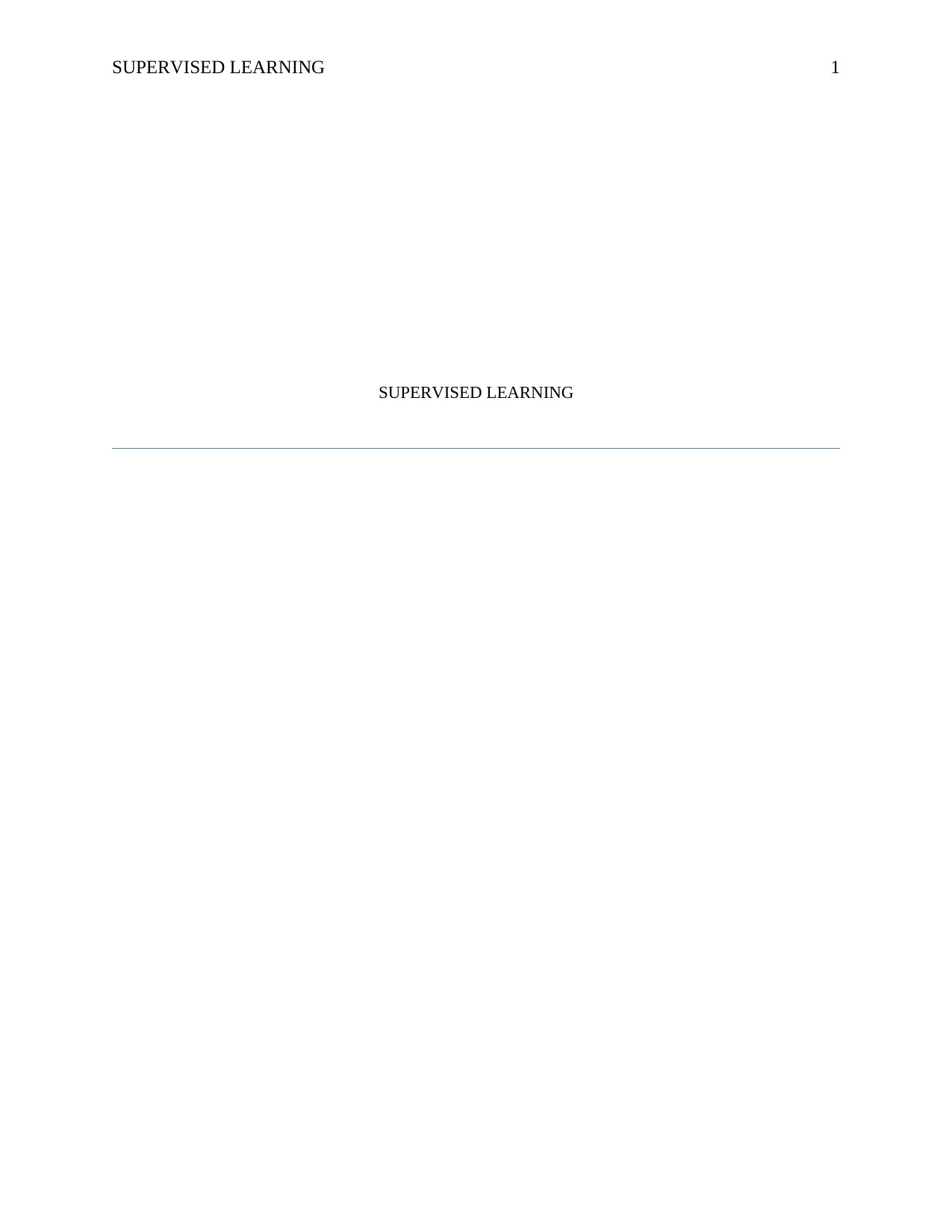
SUPERVISED LEARNING 1
SUPERVISED LEARNING
SUPERVISED LEARNING
Paraphrase This Document
Need a fresh take? Get an instant paraphrase of this document with our AI Paraphraser
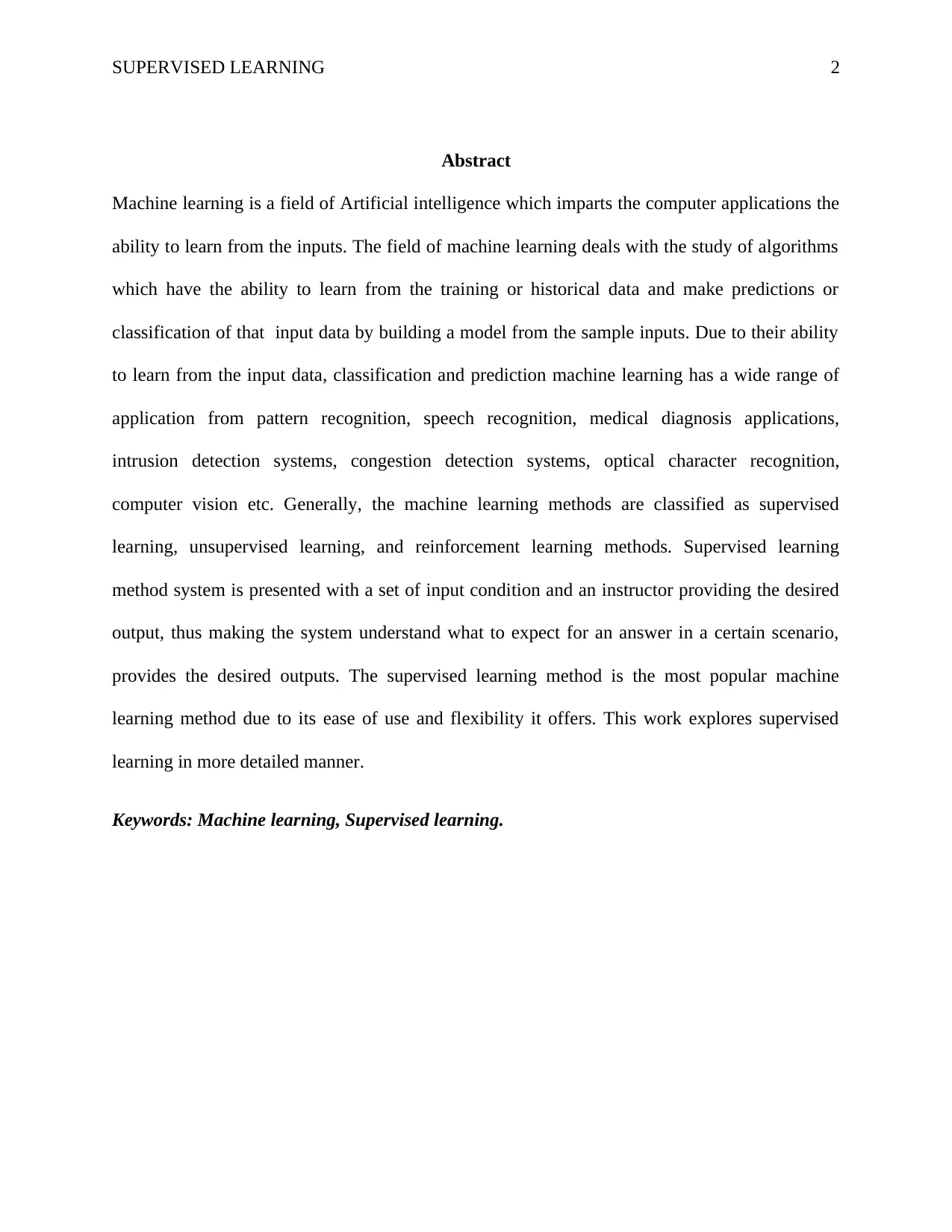
SUPERVISED LEARNING 2
Abstract
Machine learning is a field of Artificial intelligence which imparts the computer applications the
ability to learn from the inputs. The field of machine learning deals with the study of algorithms
which have the ability to learn from the training or historical data and make predictions or
classification of that input data by building a model from the sample inputs. Due to their ability
to learn from the input data, classification and prediction machine learning has a wide range of
application from pattern recognition, speech recognition, medical diagnosis applications,
intrusion detection systems, congestion detection systems, optical character recognition,
computer vision etc. Generally, the machine learning methods are classified as supervised
learning, unsupervised learning, and reinforcement learning methods. Supervised learning
method system is presented with a set of input condition and an instructor providing the desired
output, thus making the system understand what to expect for an answer in a certain scenario,
provides the desired outputs. The supervised learning method is the most popular machine
learning method due to its ease of use and flexibility it offers. This work explores supervised
learning in more detailed manner.
Keywords: Machine learning, Supervised learning.
Abstract
Machine learning is a field of Artificial intelligence which imparts the computer applications the
ability to learn from the inputs. The field of machine learning deals with the study of algorithms
which have the ability to learn from the training or historical data and make predictions or
classification of that input data by building a model from the sample inputs. Due to their ability
to learn from the input data, classification and prediction machine learning has a wide range of
application from pattern recognition, speech recognition, medical diagnosis applications,
intrusion detection systems, congestion detection systems, optical character recognition,
computer vision etc. Generally, the machine learning methods are classified as supervised
learning, unsupervised learning, and reinforcement learning methods. Supervised learning
method system is presented with a set of input condition and an instructor providing the desired
output, thus making the system understand what to expect for an answer in a certain scenario,
provides the desired outputs. The supervised learning method is the most popular machine
learning method due to its ease of use and flexibility it offers. This work explores supervised
learning in more detailed manner.
Keywords: Machine learning, Supervised learning.
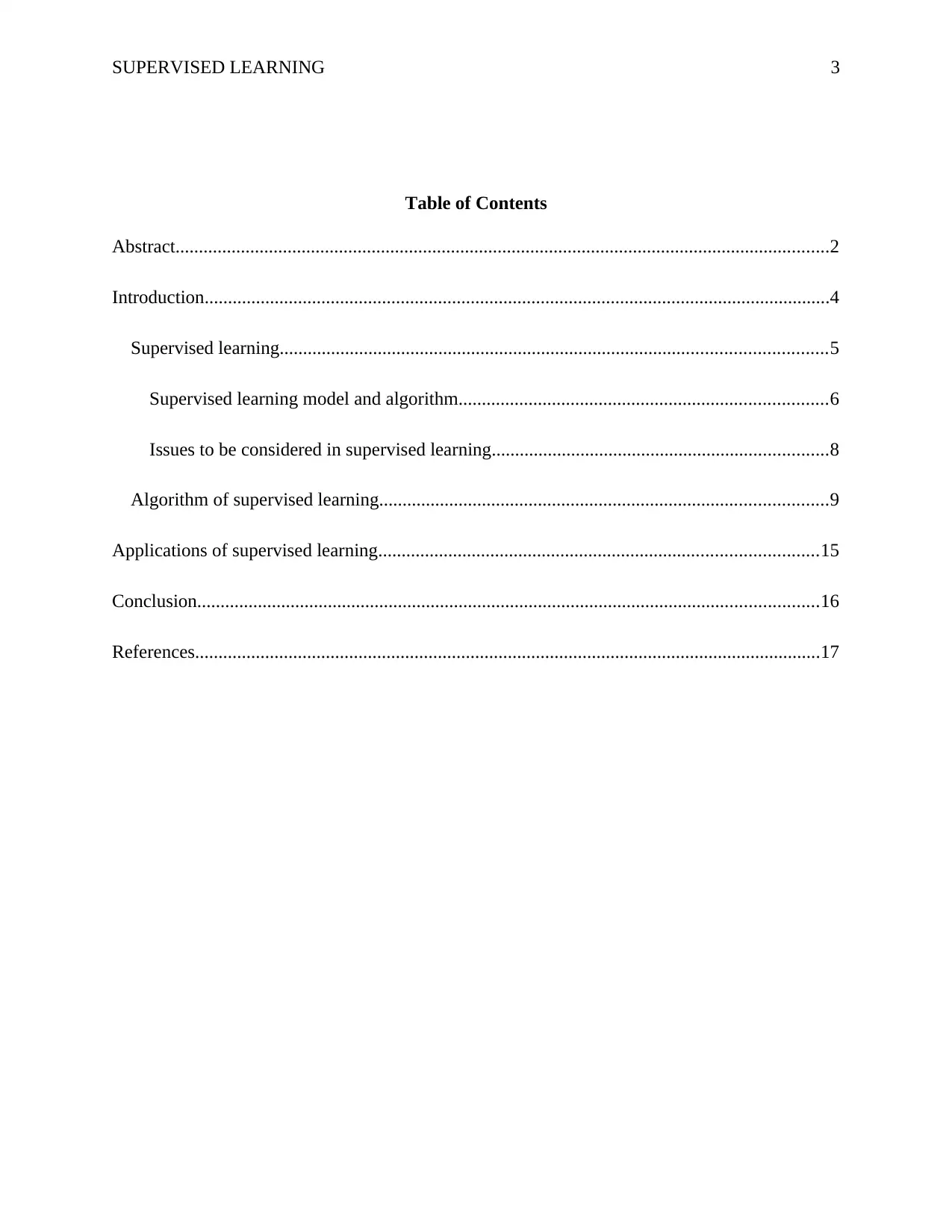
SUPERVISED LEARNING 3
Table of Contents
Abstract............................................................................................................................................2
Introduction......................................................................................................................................4
Supervised learning.....................................................................................................................5
Supervised learning model and algorithm...............................................................................6
Issues to be considered in supervised learning........................................................................8
Algorithm of supervised learning................................................................................................9
Applications of supervised learning..............................................................................................15
Conclusion.....................................................................................................................................16
References......................................................................................................................................17
Table of Contents
Abstract............................................................................................................................................2
Introduction......................................................................................................................................4
Supervised learning.....................................................................................................................5
Supervised learning model and algorithm...............................................................................6
Issues to be considered in supervised learning........................................................................8
Algorithm of supervised learning................................................................................................9
Applications of supervised learning..............................................................................................15
Conclusion.....................................................................................................................................16
References......................................................................................................................................17
⊘ This is a preview!⊘
Do you want full access?
Subscribe today to unlock all pages.

Trusted by 1+ million students worldwide
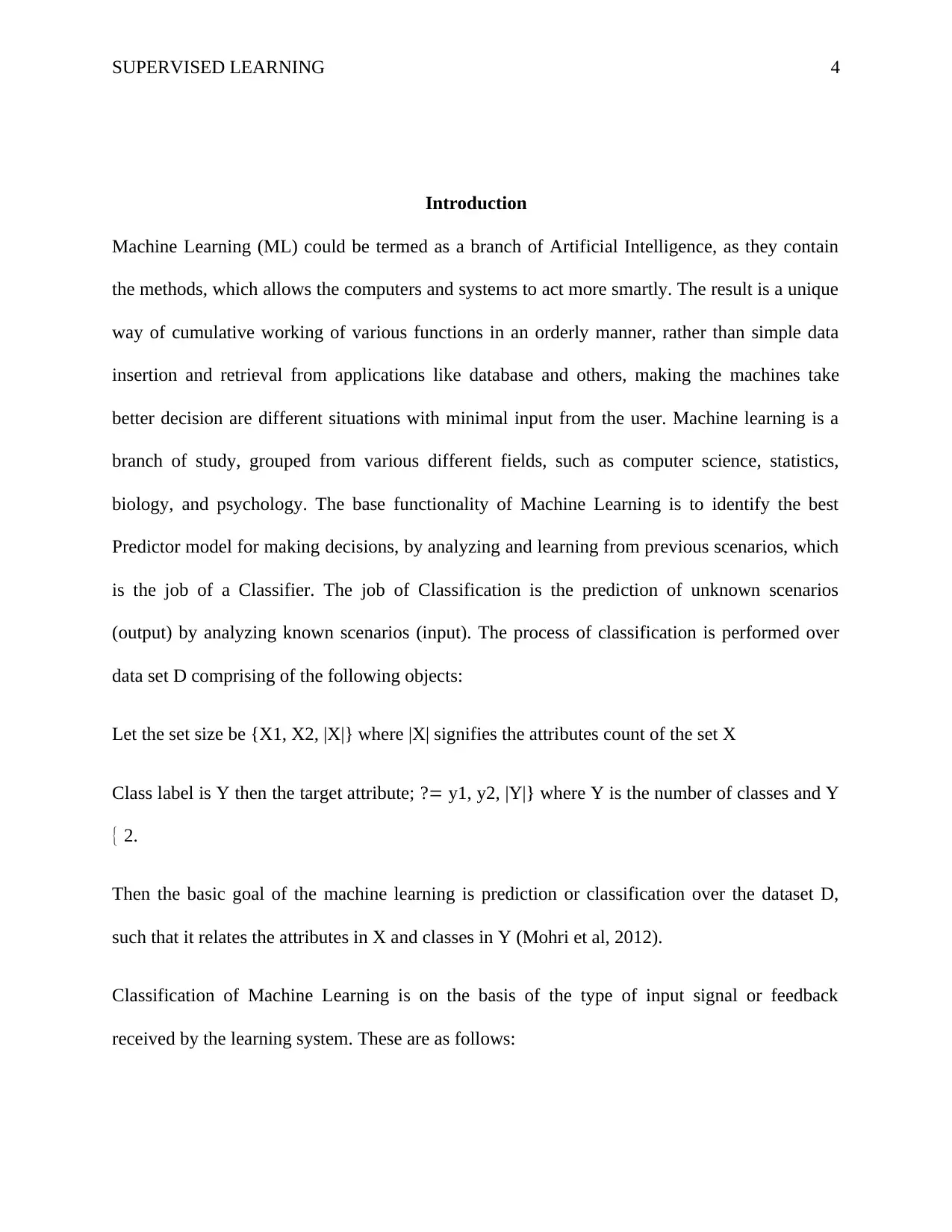
SUPERVISED LEARNING 4
Introduction
Machine Learning (ML) could be termed as a branch of Artificial Intelligence, as they contain
the methods, which allows the computers and systems to act more smartly. The result is a unique
way of cumulative working of various functions in an orderly manner, rather than simple data
insertion and retrieval from applications like database and others, making the machines take
better decision are different situations with minimal input from the user. Machine learning is a
branch of study, grouped from various different fields, such as computer science, statistics,
biology, and psychology. The base functionality of Machine Learning is to identify the best
Predictor model for making decisions, by analyzing and learning from previous scenarios, which
is the job of a Classifier. The job of Classification is the prediction of unknown scenarios
(output) by analyzing known scenarios (input). The process of classification is performed over
data set D comprising of the following objects:
Let the set size be {X1, X2, |X|} where |X| signifies the attributes count of the set X
Class label is Y then the target attribute; ? y1, y2, |Y|} where Y is the number of classes and Y
2.
Then the basic goal of the machine learning is prediction or classification over the dataset D,
such that it relates the attributes in X and classes in Y (Mohri et al, 2012).
Classification of Machine Learning is on the basis of the type of input signal or feedback
received by the learning system. These are as follows:
Introduction
Machine Learning (ML) could be termed as a branch of Artificial Intelligence, as they contain
the methods, which allows the computers and systems to act more smartly. The result is a unique
way of cumulative working of various functions in an orderly manner, rather than simple data
insertion and retrieval from applications like database and others, making the machines take
better decision are different situations with minimal input from the user. Machine learning is a
branch of study, grouped from various different fields, such as computer science, statistics,
biology, and psychology. The base functionality of Machine Learning is to identify the best
Predictor model for making decisions, by analyzing and learning from previous scenarios, which
is the job of a Classifier. The job of Classification is the prediction of unknown scenarios
(output) by analyzing known scenarios (input). The process of classification is performed over
data set D comprising of the following objects:
Let the set size be {X1, X2, |X|} where |X| signifies the attributes count of the set X
Class label is Y then the target attribute; ? y1, y2, |Y|} where Y is the number of classes and Y
2.
Then the basic goal of the machine learning is prediction or classification over the dataset D,
such that it relates the attributes in X and classes in Y (Mohri et al, 2012).
Classification of Machine Learning is on the basis of the type of input signal or feedback
received by the learning system. These are as follows:
Paraphrase This Document
Need a fresh take? Get an instant paraphrase of this document with our AI Paraphraser
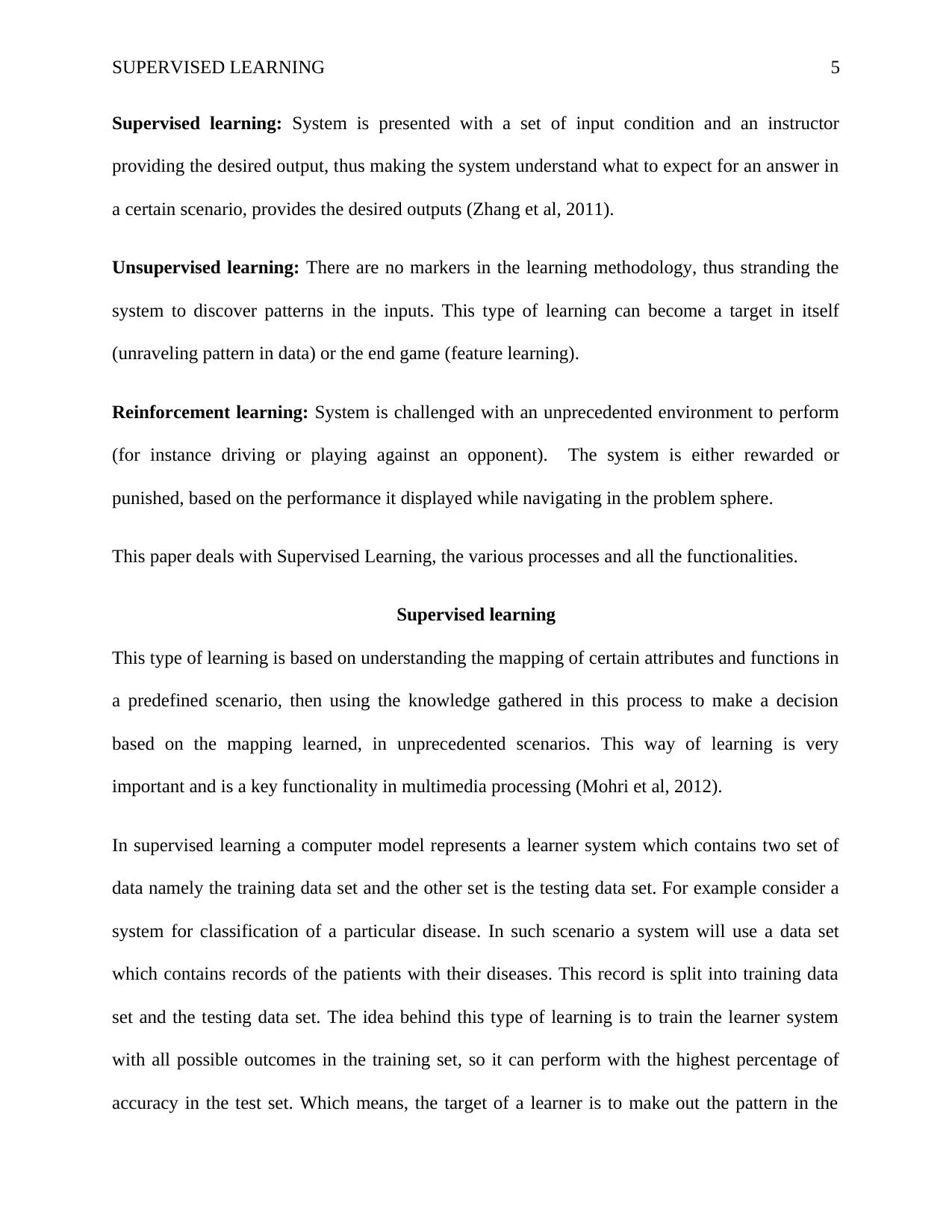
SUPERVISED LEARNING 5
Supervised learning: System is presented with a set of input condition and an instructor
providing the desired output, thus making the system understand what to expect for an answer in
a certain scenario, provides the desired outputs (Zhang et al, 2011).
Unsupervised learning: There are no markers in the learning methodology, thus stranding the
system to discover patterns in the inputs. This type of learning can become a target in itself
(unraveling pattern in data) or the end game (feature learning).
Reinforcement learning: System is challenged with an unprecedented environment to perform
(for instance driving or playing against an opponent). The system is either rewarded or
punished, based on the performance it displayed while navigating in the problem sphere.
This paper deals with Supervised Learning, the various processes and all the functionalities.
Supervised learning
This type of learning is based on understanding the mapping of certain attributes and functions in
a predefined scenario, then using the knowledge gathered in this process to make a decision
based on the mapping learned, in unprecedented scenarios. This way of learning is very
important and is a key functionality in multimedia processing (Mohri et al, 2012).
In supervised learning a computer model represents a learner system which contains two set of
data namely the training data set and the other set is the testing data set. For example consider a
system for classification of a particular disease. In such scenario a system will use a data set
which contains records of the patients with their diseases. This record is split into training data
set and the testing data set. The idea behind this type of learning is to train the learner system
with all possible outcomes in the training set, so it can perform with the highest percentage of
accuracy in the test set. Which means, the target of a learner is to make out the pattern in the
Supervised learning: System is presented with a set of input condition and an instructor
providing the desired output, thus making the system understand what to expect for an answer in
a certain scenario, provides the desired outputs (Zhang et al, 2011).
Unsupervised learning: There are no markers in the learning methodology, thus stranding the
system to discover patterns in the inputs. This type of learning can become a target in itself
(unraveling pattern in data) or the end game (feature learning).
Reinforcement learning: System is challenged with an unprecedented environment to perform
(for instance driving or playing against an opponent). The system is either rewarded or
punished, based on the performance it displayed while navigating in the problem sphere.
This paper deals with Supervised Learning, the various processes and all the functionalities.
Supervised learning
This type of learning is based on understanding the mapping of certain attributes and functions in
a predefined scenario, then using the knowledge gathered in this process to make a decision
based on the mapping learned, in unprecedented scenarios. This way of learning is very
important and is a key functionality in multimedia processing (Mohri et al, 2012).
In supervised learning a computer model represents a learner system which contains two set of
data namely the training data set and the other set is the testing data set. For example consider a
system for classification of a particular disease. In such scenario a system will use a data set
which contains records of the patients with their diseases. This record is split into training data
set and the testing data set. The idea behind this type of learning is to train the learner system
with all possible outcomes in the training set, so it can perform with the highest percentage of
accuracy in the test set. Which means, the target of a learner is to make out the pattern in the
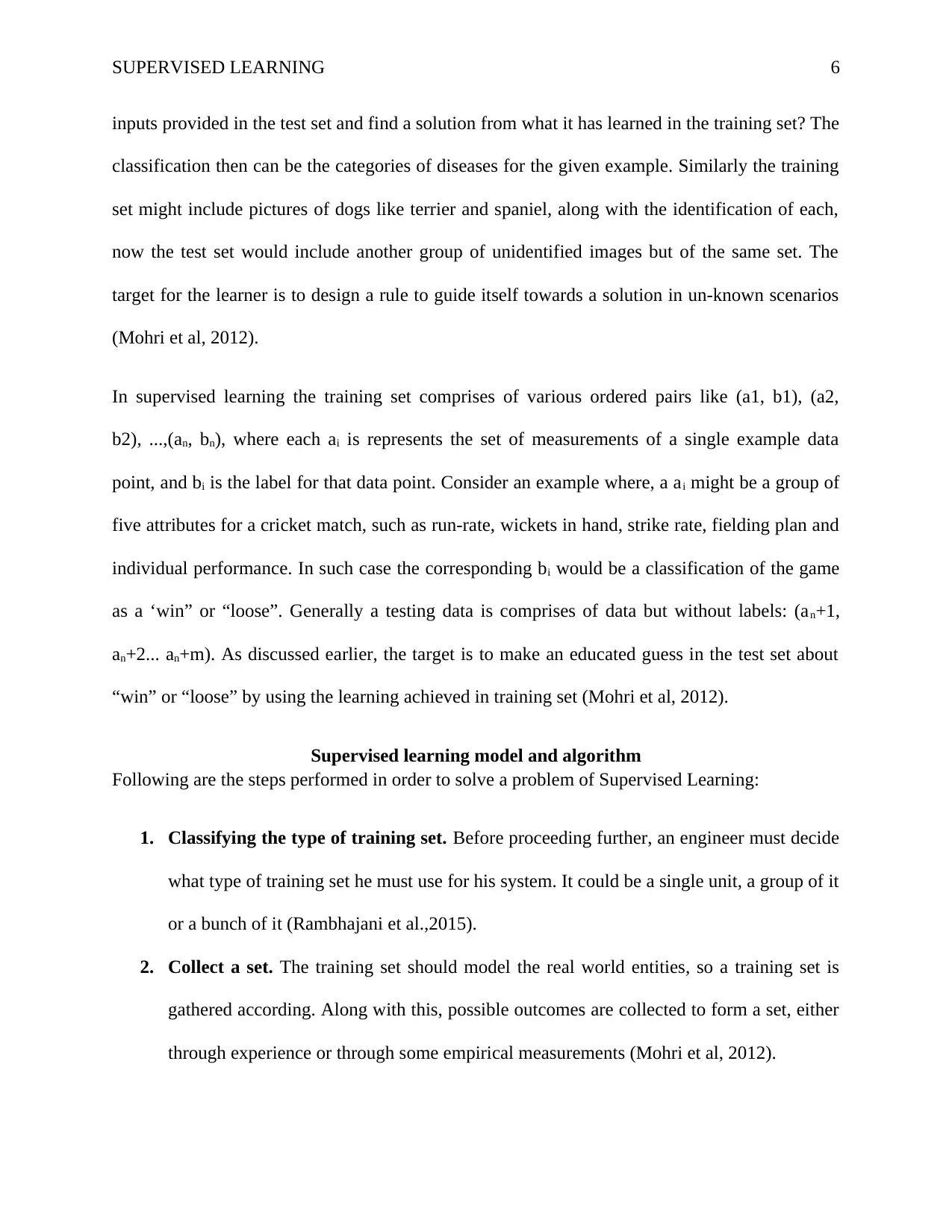
SUPERVISED LEARNING 6
inputs provided in the test set and find a solution from what it has learned in the training set? The
classification then can be the categories of diseases for the given example. Similarly the training
set might include pictures of dogs like terrier and spaniel, along with the identification of each,
now the test set would include another group of unidentified images but of the same set. The
target for the learner is to design a rule to guide itself towards a solution in un-known scenarios
(Mohri et al, 2012).
In supervised learning the training set comprises of various ordered pairs like (a1, b1), (a2,
b2), ...,(an, bn), where each ai is represents the set of measurements of a single example data
point, and bi is the label for that data point. Consider an example where, a ai might be a group of
five attributes for a cricket match, such as run-rate, wickets in hand, strike rate, fielding plan and
individual performance. In such case the corresponding bi would be a classification of the game
as a ‘win” or “loose”. Generally a testing data is comprises of data but without labels: (an+1,
an+2... an+m). As discussed earlier, the target is to make an educated guess in the test set about
“win” or “loose” by using the learning achieved in training set (Mohri et al, 2012).
Supervised learning model and algorithm
Following are the steps performed in order to solve a problem of Supervised Learning:
1. Classifying the type of training set. Before proceeding further, an engineer must decide
what type of training set he must use for his system. It could be a single unit, a group of it
or a bunch of it (Rambhajani et al.,2015).
2. Collect a set. The training set should model the real world entities, so a training set is
gathered according. Along with this, possible outcomes are collected to form a set, either
through experience or through some empirical measurements (Mohri et al, 2012).
inputs provided in the test set and find a solution from what it has learned in the training set? The
classification then can be the categories of diseases for the given example. Similarly the training
set might include pictures of dogs like terrier and spaniel, along with the identification of each,
now the test set would include another group of unidentified images but of the same set. The
target for the learner is to design a rule to guide itself towards a solution in un-known scenarios
(Mohri et al, 2012).
In supervised learning the training set comprises of various ordered pairs like (a1, b1), (a2,
b2), ...,(an, bn), where each ai is represents the set of measurements of a single example data
point, and bi is the label for that data point. Consider an example where, a ai might be a group of
five attributes for a cricket match, such as run-rate, wickets in hand, strike rate, fielding plan and
individual performance. In such case the corresponding bi would be a classification of the game
as a ‘win” or “loose”. Generally a testing data is comprises of data but without labels: (an+1,
an+2... an+m). As discussed earlier, the target is to make an educated guess in the test set about
“win” or “loose” by using the learning achieved in training set (Mohri et al, 2012).
Supervised learning model and algorithm
Following are the steps performed in order to solve a problem of Supervised Learning:
1. Classifying the type of training set. Before proceeding further, an engineer must decide
what type of training set he must use for his system. It could be a single unit, a group of it
or a bunch of it (Rambhajani et al.,2015).
2. Collect a set. The training set should model the real world entities, so a training set is
gathered according. Along with this, possible outcomes are collected to form a set, either
through experience or through some empirical measurements (Mohri et al, 2012).
⊘ This is a preview!⊘
Do you want full access?
Subscribe today to unlock all pages.

Trusted by 1+ million students worldwide
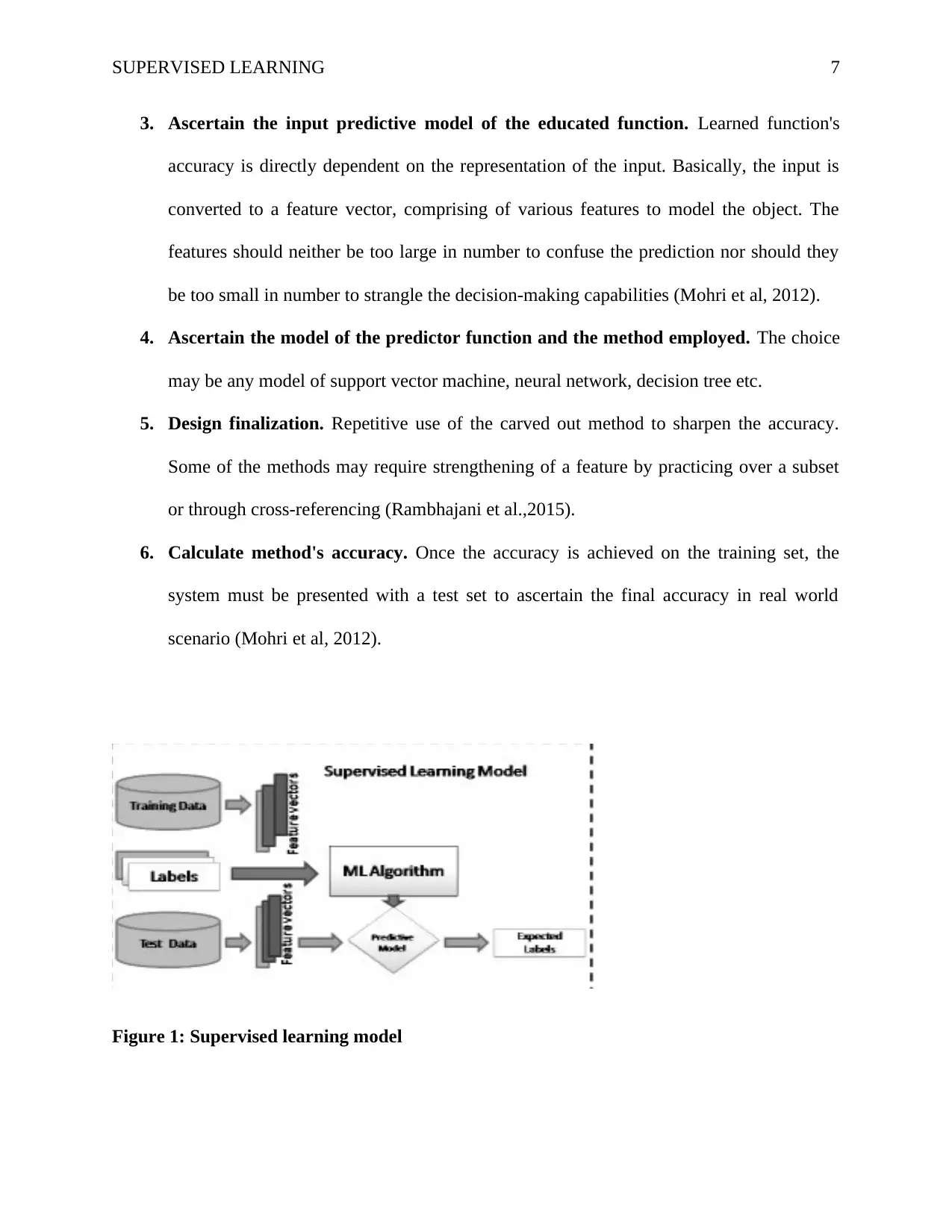
SUPERVISED LEARNING 7
3. Ascertain the input predictive model of the educated function. Learned function's
accuracy is directly dependent on the representation of the input. Basically, the input is
converted to a feature vector, comprising of various features to model the object. The
features should neither be too large in number to confuse the prediction nor should they
be too small in number to strangle the decision-making capabilities (Mohri et al, 2012).
4. Ascertain the model of the predictor function and the method employed. The choice
may be any model of support vector machine, neural network, decision tree etc.
5. Design finalization. Repetitive use of the carved out method to sharpen the accuracy.
Some of the methods may require strengthening of a feature by practicing over a subset
or through cross-referencing (Rambhajani et al.,2015).
6. Calculate method's accuracy. Once the accuracy is achieved on the training set, the
system must be presented with a test set to ascertain the final accuracy in real world
scenario (Mohri et al, 2012).
Figure 1: Supervised learning model
3. Ascertain the input predictive model of the educated function. Learned function's
accuracy is directly dependent on the representation of the input. Basically, the input is
converted to a feature vector, comprising of various features to model the object. The
features should neither be too large in number to confuse the prediction nor should they
be too small in number to strangle the decision-making capabilities (Mohri et al, 2012).
4. Ascertain the model of the predictor function and the method employed. The choice
may be any model of support vector machine, neural network, decision tree etc.
5. Design finalization. Repetitive use of the carved out method to sharpen the accuracy.
Some of the methods may require strengthening of a feature by practicing over a subset
or through cross-referencing (Rambhajani et al.,2015).
6. Calculate method's accuracy. Once the accuracy is achieved on the training set, the
system must be presented with a test set to ascertain the final accuracy in real world
scenario (Mohri et al, 2012).
Figure 1: Supervised learning model
Paraphrase This Document
Need a fresh take? Get an instant paraphrase of this document with our AI Paraphraser
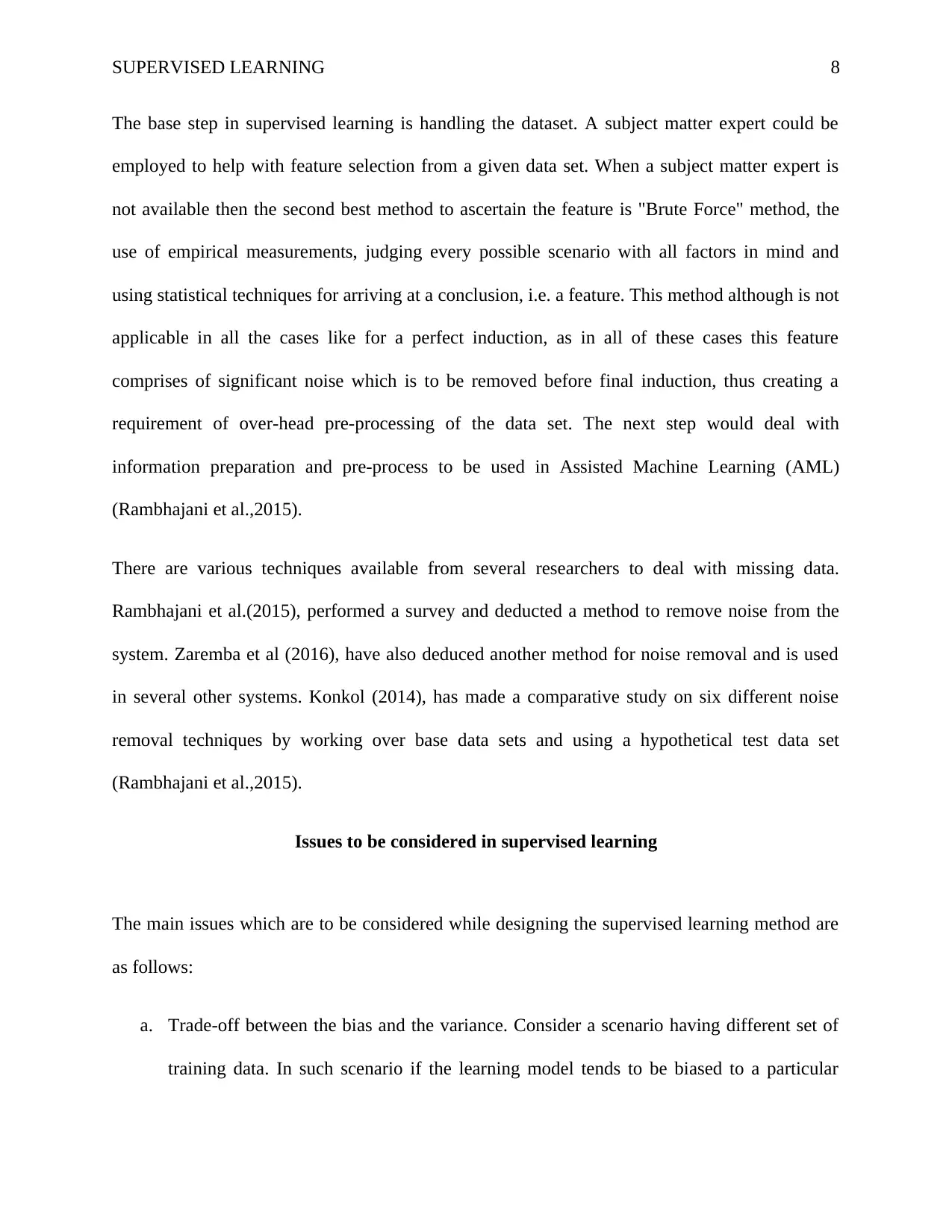
SUPERVISED LEARNING 8
The base step in supervised learning is handling the dataset. A subject matter expert could be
employed to help with feature selection from a given data set. When a subject matter expert is
not available then the second best method to ascertain the feature is "Brute Force" method, the
use of empirical measurements, judging every possible scenario with all factors in mind and
using statistical techniques for arriving at a conclusion, i.e. a feature. This method although is not
applicable in all the cases like for a perfect induction, as in all of these cases this feature
comprises of significant noise which is to be removed before final induction, thus creating a
requirement of over-head pre-processing of the data set. The next step would deal with
information preparation and pre-process to be used in Assisted Machine Learning (AML)
(Rambhajani et al.,2015).
There are various techniques available from several researchers to deal with missing data.
Rambhajani et al.(2015), performed a survey and deducted a method to remove noise from the
system. Zaremba et al (2016), have also deduced another method for noise removal and is used
in several other systems. Konkol (2014), has made a comparative study on six different noise
removal techniques by working over base data sets and using a hypothetical test data set
(Rambhajani et al.,2015).
Issues to be considered in supervised learning
The main issues which are to be considered while designing the supervised learning method are
as follows:
a. Trade-off between the bias and the variance. Consider a scenario having different set of
training data. In such scenario if the learning model tends to be biased to a particular
The base step in supervised learning is handling the dataset. A subject matter expert could be
employed to help with feature selection from a given data set. When a subject matter expert is
not available then the second best method to ascertain the feature is "Brute Force" method, the
use of empirical measurements, judging every possible scenario with all factors in mind and
using statistical techniques for arriving at a conclusion, i.e. a feature. This method although is not
applicable in all the cases like for a perfect induction, as in all of these cases this feature
comprises of significant noise which is to be removed before final induction, thus creating a
requirement of over-head pre-processing of the data set. The next step would deal with
information preparation and pre-process to be used in Assisted Machine Learning (AML)
(Rambhajani et al.,2015).
There are various techniques available from several researchers to deal with missing data.
Rambhajani et al.(2015), performed a survey and deducted a method to remove noise from the
system. Zaremba et al (2016), have also deduced another method for noise removal and is used
in several other systems. Konkol (2014), has made a comparative study on six different noise
removal techniques by working over base data sets and using a hypothetical test data set
(Rambhajani et al.,2015).
Issues to be considered in supervised learning
The main issues which are to be considered while designing the supervised learning method are
as follows:
a. Trade-off between the bias and the variance. Consider a scenario having different set of
training data. In such scenario if the learning model tends to be biased to a particular
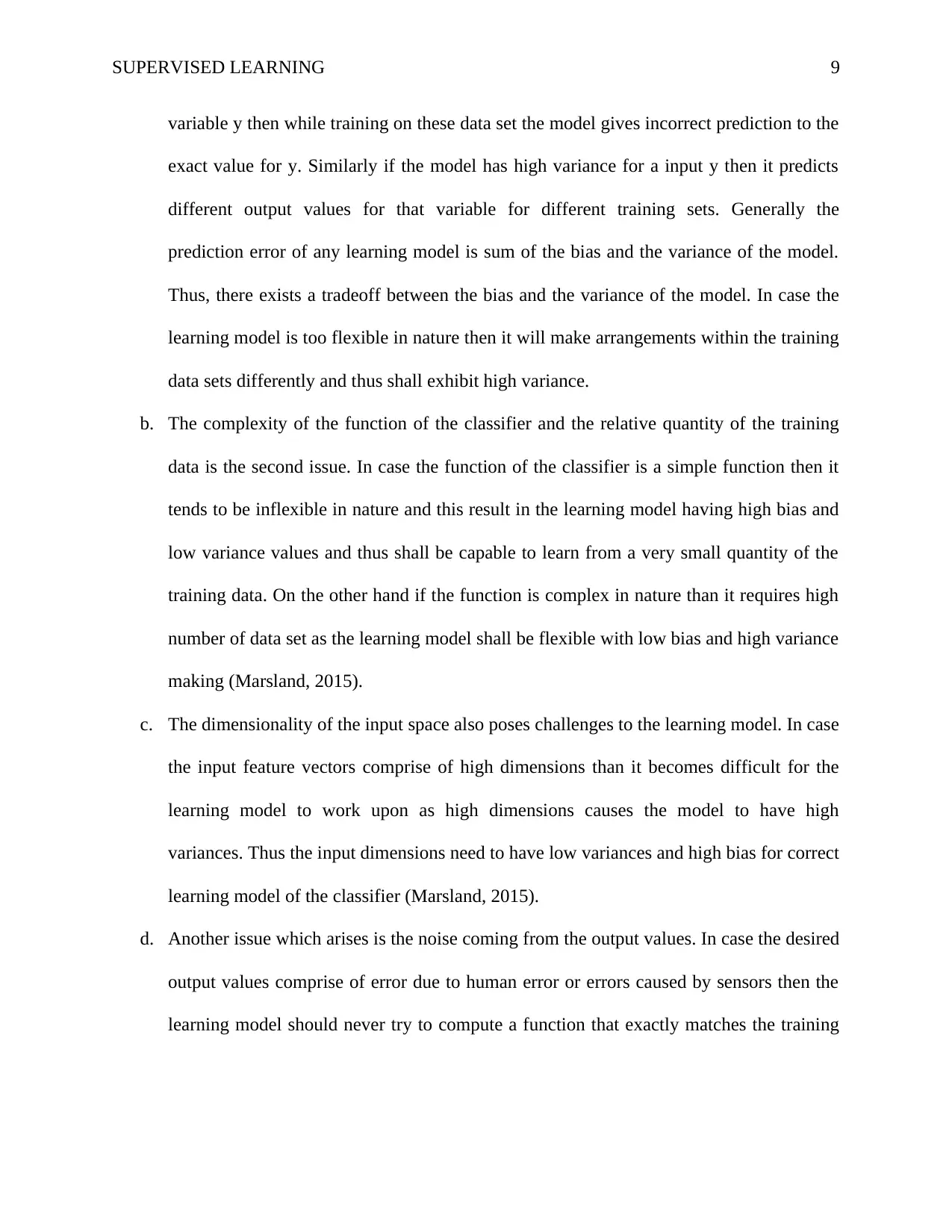
SUPERVISED LEARNING 9
variable y then while training on these data set the model gives incorrect prediction to the
exact value for y. Similarly if the model has high variance for a input y then it predicts
different output values for that variable for different training sets. Generally the
prediction error of any learning model is sum of the bias and the variance of the model.
Thus, there exists a tradeoff between the bias and the variance of the model. In case the
learning model is too flexible in nature then it will make arrangements within the training
data sets differently and thus shall exhibit high variance.
b. The complexity of the function of the classifier and the relative quantity of the training
data is the second issue. In case the function of the classifier is a simple function then it
tends to be inflexible in nature and this result in the learning model having high bias and
low variance values and thus shall be capable to learn from a very small quantity of the
training data. On the other hand if the function is complex in nature than it requires high
number of data set as the learning model shall be flexible with low bias and high variance
making (Marsland, 2015).
c. The dimensionality of the input space also poses challenges to the learning model. In case
the input feature vectors comprise of high dimensions than it becomes difficult for the
learning model to work upon as high dimensions causes the model to have high
variances. Thus the input dimensions need to have low variances and high bias for correct
learning model of the classifier (Marsland, 2015).
d. Another issue which arises is the noise coming from the output values. In case the desired
output values comprise of error due to human error or errors caused by sensors then the
learning model should never try to compute a function that exactly matches the training
variable y then while training on these data set the model gives incorrect prediction to the
exact value for y. Similarly if the model has high variance for a input y then it predicts
different output values for that variable for different training sets. Generally the
prediction error of any learning model is sum of the bias and the variance of the model.
Thus, there exists a tradeoff between the bias and the variance of the model. In case the
learning model is too flexible in nature then it will make arrangements within the training
data sets differently and thus shall exhibit high variance.
b. The complexity of the function of the classifier and the relative quantity of the training
data is the second issue. In case the function of the classifier is a simple function then it
tends to be inflexible in nature and this result in the learning model having high bias and
low variance values and thus shall be capable to learn from a very small quantity of the
training data. On the other hand if the function is complex in nature than it requires high
number of data set as the learning model shall be flexible with low bias and high variance
making (Marsland, 2015).
c. The dimensionality of the input space also poses challenges to the learning model. In case
the input feature vectors comprise of high dimensions than it becomes difficult for the
learning model to work upon as high dimensions causes the model to have high
variances. Thus the input dimensions need to have low variances and high bias for correct
learning model of the classifier (Marsland, 2015).
d. Another issue which arises is the noise coming from the output values. In case the desired
output values comprise of error due to human error or errors caused by sensors then the
learning model should never try to compute a function that exactly matches the training
⊘ This is a preview!⊘
Do you want full access?
Subscribe today to unlock all pages.

Trusted by 1+ million students worldwide
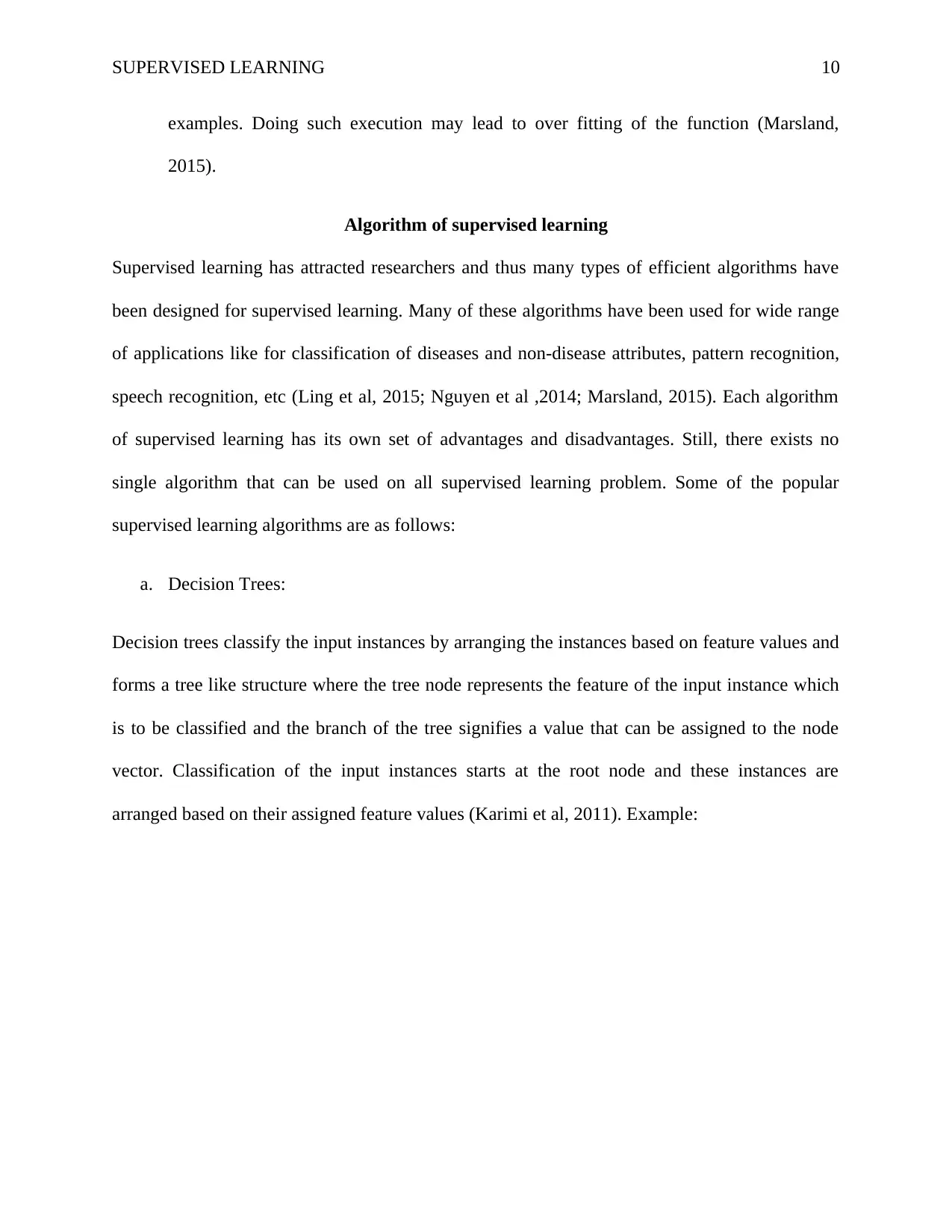
SUPERVISED LEARNING 10
examples. Doing such execution may lead to over fitting of the function (Marsland,
2015).
Algorithm of supervised learning
Supervised learning has attracted researchers and thus many types of efficient algorithms have
been designed for supervised learning. Many of these algorithms have been used for wide range
of applications like for classification of diseases and non-disease attributes, pattern recognition,
speech recognition, etc (Ling et al, 2015; Nguyen et al ,2014; Marsland, 2015). Each algorithm
of supervised learning has its own set of advantages and disadvantages. Still, there exists no
single algorithm that can be used on all supervised learning problem. Some of the popular
supervised learning algorithms are as follows:
a. Decision Trees:
Decision trees classify the input instances by arranging the instances based on feature values and
forms a tree like structure where the tree node represents the feature of the input instance which
is to be classified and the branch of the tree signifies a value that can be assigned to the node
vector. Classification of the input instances starts at the root node and these instances are
arranged based on their assigned feature values (Karimi et al, 2011). Example:
examples. Doing such execution may lead to over fitting of the function (Marsland,
2015).
Algorithm of supervised learning
Supervised learning has attracted researchers and thus many types of efficient algorithms have
been designed for supervised learning. Many of these algorithms have been used for wide range
of applications like for classification of diseases and non-disease attributes, pattern recognition,
speech recognition, etc (Ling et al, 2015; Nguyen et al ,2014; Marsland, 2015). Each algorithm
of supervised learning has its own set of advantages and disadvantages. Still, there exists no
single algorithm that can be used on all supervised learning problem. Some of the popular
supervised learning algorithms are as follows:
a. Decision Trees:
Decision trees classify the input instances by arranging the instances based on feature values and
forms a tree like structure where the tree node represents the feature of the input instance which
is to be classified and the branch of the tree signifies a value that can be assigned to the node
vector. Classification of the input instances starts at the root node and these instances are
arranged based on their assigned feature values (Karimi et al, 2011). Example:
Paraphrase This Document
Need a fresh take? Get an instant paraphrase of this document with our AI Paraphraser
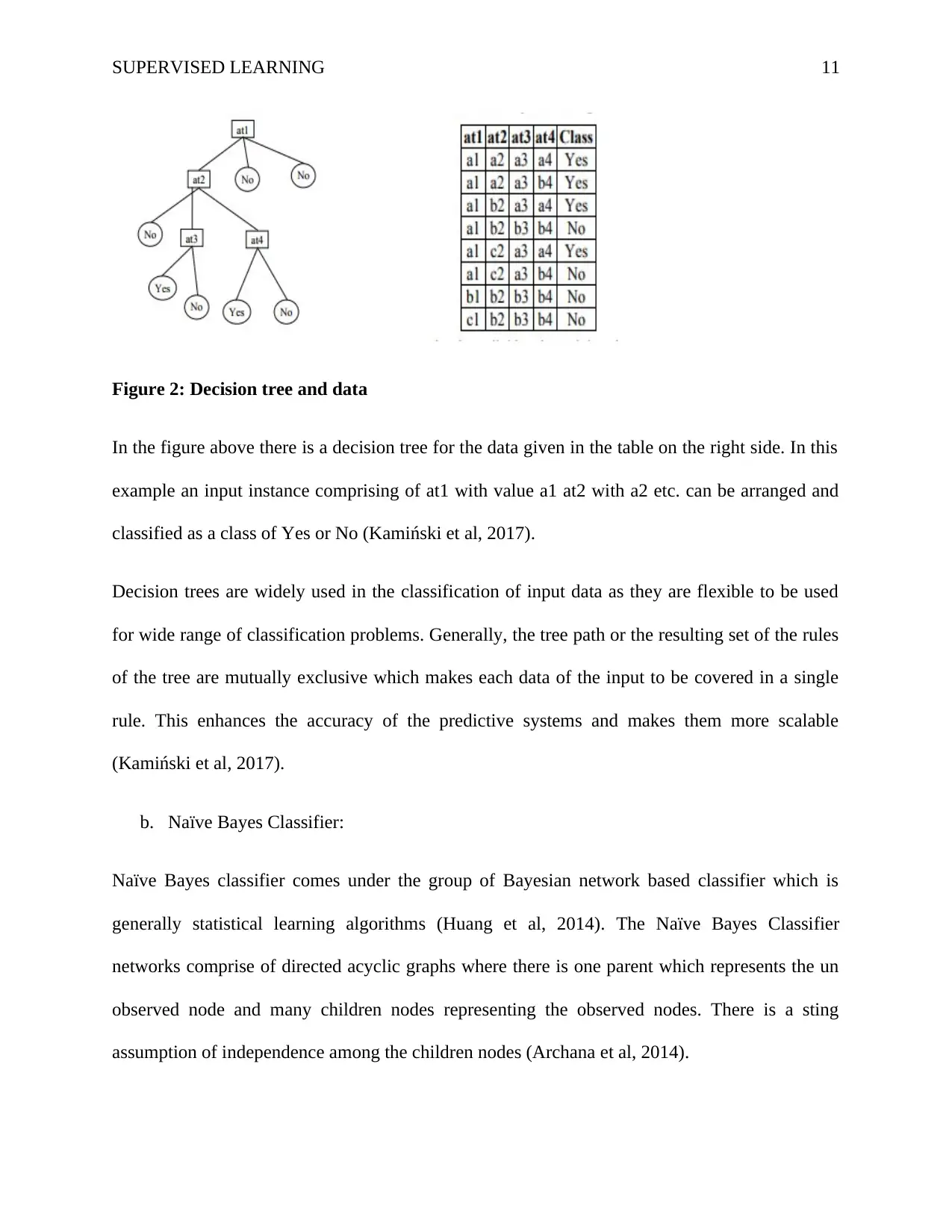
SUPERVISED LEARNING 11
Figure 2: Decision tree and data
In the figure above there is a decision tree for the data given in the table on the right side. In this
example an input instance comprising of at1 with value a1 at2 with a2 etc. can be arranged and
classified as a class of Yes or No (Kamiński et al, 2017).
Decision trees are widely used in the classification of input data as they are flexible to be used
for wide range of classification problems. Generally, the tree path or the resulting set of the rules
of the tree are mutually exclusive which makes each data of the input to be covered in a single
rule. This enhances the accuracy of the predictive systems and makes them more scalable
(Kamiński et al, 2017).
b. Naïve Bayes Classifier:
Naïve Bayes classifier comes under the group of Bayesian network based classifier which is
generally statistical learning algorithms (Huang et al, 2014). The Naïve Bayes Classifier
networks comprise of directed acyclic graphs where there is one parent which represents the un
observed node and many children nodes representing the observed nodes. There is a sting
assumption of independence among the children nodes (Archana et al, 2014).
Figure 2: Decision tree and data
In the figure above there is a decision tree for the data given in the table on the right side. In this
example an input instance comprising of at1 with value a1 at2 with a2 etc. can be arranged and
classified as a class of Yes or No (Kamiński et al, 2017).
Decision trees are widely used in the classification of input data as they are flexible to be used
for wide range of classification problems. Generally, the tree path or the resulting set of the rules
of the tree are mutually exclusive which makes each data of the input to be covered in a single
rule. This enhances the accuracy of the predictive systems and makes them more scalable
(Kamiński et al, 2017).
b. Naïve Bayes Classifier:
Naïve Bayes classifier comes under the group of Bayesian network based classifier which is
generally statistical learning algorithms (Huang et al, 2014). The Naïve Bayes Classifier
networks comprise of directed acyclic graphs where there is one parent which represents the un
observed node and many children nodes representing the observed nodes. There is a sting
assumption of independence among the children nodes (Archana et al, 2014).
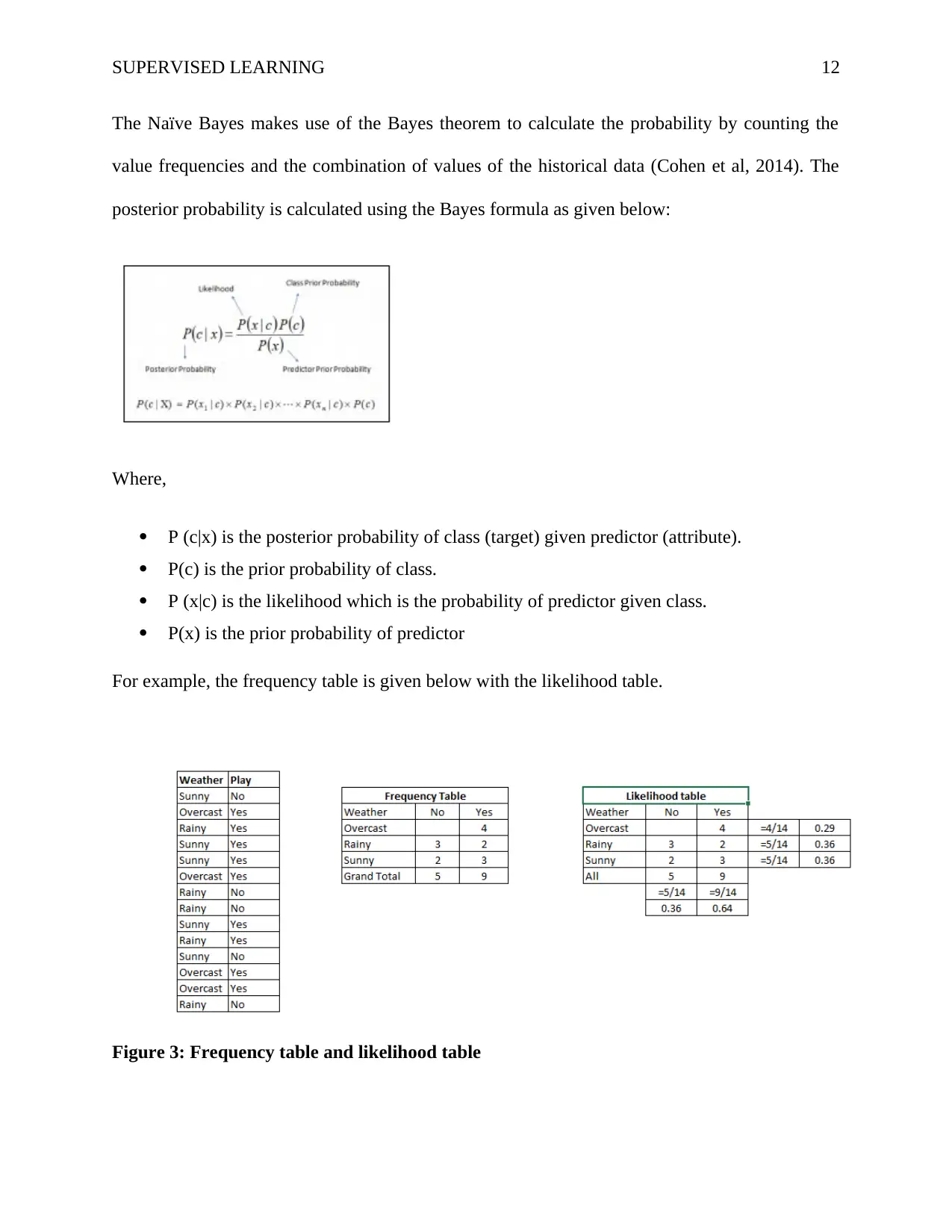
SUPERVISED LEARNING 12
The Naïve Bayes makes use of the Bayes theorem to calculate the probability by counting the
value frequencies and the combination of values of the historical data (Cohen et al, 2014). The
posterior probability is calculated using the Bayes formula as given below:
Where,
P (c|x) is the posterior probability of class (target) given predictor (attribute).
P(c) is the prior probability of class.
P (x|c) is the likelihood which is the probability of predictor given class.
P(x) is the prior probability of predictor
For example, the frequency table is given below with the likelihood table.
Figure 3: Frequency table and likelihood table
The Naïve Bayes makes use of the Bayes theorem to calculate the probability by counting the
value frequencies and the combination of values of the historical data (Cohen et al, 2014). The
posterior probability is calculated using the Bayes formula as given below:
Where,
P (c|x) is the posterior probability of class (target) given predictor (attribute).
P(c) is the prior probability of class.
P (x|c) is the likelihood which is the probability of predictor given class.
P(x) is the prior probability of predictor
For example, the frequency table is given below with the likelihood table.
Figure 3: Frequency table and likelihood table
⊘ This is a preview!⊘
Do you want full access?
Subscribe today to unlock all pages.

Trusted by 1+ million students worldwide
1 out of 22
Related Documents
Your All-in-One AI-Powered Toolkit for Academic Success.
+13062052269
info@desklib.com
Available 24*7 on WhatsApp / Email
![[object Object]](/_next/static/media/star-bottom.7253800d.svg)
Unlock your academic potential
Copyright © 2020–2025 A2Z Services. All Rights Reserved. Developed and managed by ZUCOL.





